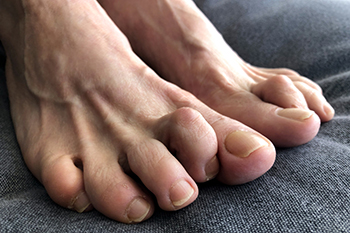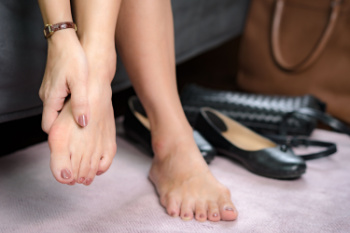Connect With Us
Blog

Hammertoe is a condition in which a toe bends at the middle joint, causing it to look like a hammer. Hammertoe is often caused by muscle imbalance that leads to pain, stiffness, and difficulty wearing shoes. If conservative treatment measures do not help, a podiatrist may recommend surgery to correct the deformity. The type of procedure depends on the flexibility of the toe. If the toe is still movable, a tendon transfer can help straighten it by repositioning tendons. For a rigid hammertoe, joint resection involves removing a small section of bone to allow the toe to extend. Joint fusion surgery permanently realigns the toe by securing the bones together with pins or screws until they heal. These procedures are typically performed on an outpatient basis, with recovery taking several weeks. Swelling can last for months, but pain generally recedes early in the healing process. Possible risks include infection, nerve damage, or recurrence of the deformity. If you have a painful hammertoe, it is suggested that you schedule an appointment with a podiatrist for an exam, diagnosis, and treatment options, which may include surgery.
Foot surgery is sometimes necessary to treat a foot ailment. To learn more, contact Lawrence Fallat, DPM of Michigan. Our doctor will assist you with all of your foot and ankle needs.
When Is Surgery Necessary?
Foot and ankle surgery is generally reserved for cases in which less invasive, conservative procedures have failed to alleviate the problem. Some of the cases in which surgery may be necessary include:
- Removing foot deformities like bunions and bone spurs
- Severe arthritis that has caused bone issues
- Cosmetic reconstruction
What Types of Surgery Are There?
The type of surgery you receive will depend on the nature of the problem you have. Some of the possible surgeries include:
- Bunionectomy for painful bunions
- Surgical fusion for realignment of bones
- Neuropathy decompression surgery to treat nerve damage
Benefits of Surgery
Although surgery is usually a last resort, it can provide more complete pain relief compared to non-surgical methods and may allow you to finally resume full activity.
Surgical techniques have also become increasingly sophisticated. Techniques like endoscopic surgery allow for smaller incisions and faster recovery times.
If you have any questions please feel free to contact our offices located in Canton and Taylor, MI . We offer the newest diagnostic and treatment technologies for all your foot and ankle needs.

Bunions tend to worsen over time and are more prevalent in women due to a combination of genetic, structural, and footwear-related factors. Aging weakens connective tissues, leading to joint instability and increased toe misalignment. Women are particularly at risk because of shoes with narrow toe boxes and high heels, which place excessive pressure on the forefoot and push the big toe out of alignment. Hormonal changes may also contribute by affecting ligament flexibility. As bunions progress, they can cause pain, swelling, and difficulty walking. Choosing supportive, wide-toe shoes and avoiding prolonged use of restrictive footwear can help slow progression. Strengthening foot muscles with targeted exercises may also provide relief. For persistent discomfort or severe deformity, it is suggested that you see a podiatrist who can offer personalized solutions, including orthotics, padding, or surgical options to improve comfort and function as the condition advances.
If you are suffering from bunion pain, contact Lawrence Fallat, DPM of Michigan. Our doctor can provide the care you need to keep you pain-free and on your feet.
What Is a Bunion?
Bunions are painful bony bumps that usually develop on the inside of the foot at the joint of the big toe. As the deformity increases over time, it may become painful to walk and wear shoes. Women are more likely to exacerbate existing bunions since they often wear tight, narrow shoes that shift their toes together. Bunion pain can be relieved by wearing wider shoes with enough room for the toes.
Causes
- Genetics – some people inherit feet that are more prone to bunion development
- Inflammatory Conditions - rheumatoid arthritis and polio may cause bunion development
Symptoms
- Redness and inflammation
- Pain and tenderness
- Callus or corns on the bump
- Restricted motion in the big toe
In order to diagnose your bunion, your podiatrist may ask about your medical history, symptoms, and general health. Your doctor might also order an x-ray to take a closer look at your feet. Nonsurgical treatment options include orthotics, padding, icing, changes in footwear, and medication. If nonsurgical treatments don’t alleviate your bunion pain, surgery may be necessary.
If you have any questions, please feel free to contact our offices located in Canton and Taylor, MI . We offer the newest diagnostic and treatment technologies for all your foot care needs.

Sever's disease, also known as calcaneal apophysitis, is a common cause of heel pain in growing children and adolescents, especially those involved in sports. It occurs when the growth plate in the heel, called the calcaneal apophysis, becomes inflamed due to repetitive stress. The condition typically affects children between the ages of eight and 14. Risk factors for Sever's disease include frequent physical activity, particularly high-impact sports like running, soccer, and basketball. Overuse, tight calf muscles, and growth spurts can increase the likelihood of developing this condition. Symptoms include heel pain, tenderness, and swelling, often worse during or after physical activity. Children may also limp or have difficulty walking comfortably. If your active child has heel pain, it is suggested that you schedule an appointment with a podiatrist who can accurately diagnose and treat what may be going on.
Sever's disease often occurs in children and teens. If your child is experiencing foot or ankle pain, see Lawrence Fallat, DPM from Michigan. Our doctor can treat your child’s foot and ankle needs.
Sever’s Disease
Sever’s disease is also known as calcaneal apophysitis, which is a medical condition that causes heel pain I none or both feet. The disease is known to affect children between the ages of 8 and 14.
Sever’s disease occurs when part of the child’s heel known as the growth plate (calcaneal epiphysis) is attached to the Achilles tendon. This area can suffer injury when the muscles and tendons of the growing foot do not keep pace with bone growth. Therefore, the constant pain which one experiences at the back of the heel will make the child unable to put any weight on the heel. The child is then forced to walk on their toes.
Symptoms
Acute pain – Pain associated with Sever’s disease is usually felt in the heel when the child engages in physical activity such as walking, jumping and or running.
Highly active – Children who are very active are among the most susceptible in experiencing Sever’s disease, because of the stress and tension placed on their feet.
If you have any questions, please feel free to contact our offices located in Canton and Taylor, MI . We offer the newest diagnostic and treatment technologies for all your foot and ankle injuries.

